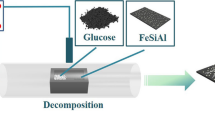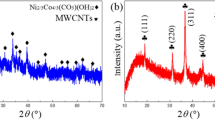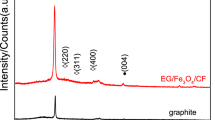Abstract
Designing the structure with dielectric loss and magnetic loss integrated contributes to expansion of microwave absorption bandwidth. Nanohybrid materials composed of iron oxide (Fe3O4) and multiwalled carbon nanotubes (MWCNTs) were prepared through a newly electrostatic attraction method as high-performance microwave absorbers in the 2–18 GHz band. The nanohybrids are characterized by transmission electron microscopy, X-ray diffraction, and vector network analysis. Microstructural analysis showed that Fe3O4 and MWCNTs were well-connected through electrostatic interaction in the nanohybrids. The experimental results indicated that MWCNTs/PEDOT: PSS/Fe3O4 possessed higher reflection loss and broader absorption bandwidth than MWCNTs. MWCNTs/SDBS/Fe3O4 had better matching of dielectric loss and magnetic loss, the absorption bandwidth below − 10 dB was up to 8 GHz. This work further reveals that the novel electrostatic attraction method could be efficiently enlarged electromagnetic wave attenuation performance in absorb materials.
Similar content being viewed by others
Explore related subjects
Discover the latest articles, news and stories from top researchers in related subjects.Avoid common mistakes on your manuscript.
Introduction
Electromagnetic shielding and attenuation materials based on excellent dielectric and magnetic properties are drawing increasing attention to the significant applications in aircrafts, communication devices, cutting-edge electronics, and health protection [1,2,3,4,5,6,7]. Serious electromagnetic interference pollution is so ubiquitous that finding efficient microwave absorbers with superior absorption performances at specific frequency band is becoming highly desirable and necessary [8].
Based on the absorption mechanism, microwave absorbers can be classified into two categories: dielectric loss absorbers and magnetic loss absorber [9]. Dielectric loss absorbers comprise graphite, carbon nanotube, carbon particles, and SiC. Magnetic loss absorbers include metal compounds such as Fe3O4, magnetic metal (Fe, Ni), and hydroxy-Fe [10]. However, dielectric and magnetic absorbers both have shortcoming of low attenuation ability when they are utilized alone in the microwave band of 2–18 GHz. Dielectric loss absorbers have a low absorption efficiency, while magnetic loss absorbers are heavy and poor heat resistance. Nanohybrids composed of those two absorbers with controlled structure and interface interaction may exhibit synergistic properties and show great potential as high-performance microwave absorbers.
Multiwalled carbon nanotubes (MWCNTs) have great potential as microwave absorbers because of their unique chemical structure and electrical and magnetic properties [11,12,13]. It is necessary to modify MWCNTs by coating, filling, or doping with other nanomaterials in order to improve microwave absorption properties. In the previous studies, three routes were applied to improve the dielectric loss or magnetic loss of MWCNTs. Firstly, coating MWCNTs with conductive polymer. A. Choudhury synthesized the nanohybrids of protonic acid doped poly(o-toluidine) with carboxyl-functionalized MWCNTs by in situ chemical oxidation polymerization to improve dielectric constantly and loss significantly [14]. Secondly, MWCNTs hybrids with dielectric materials, some researchers used BaTiO3 and TiO2 to develop novel absorption materials. The absorption strength could reach − 40 dB, but the bandwidth below − 10 dB did not show any enhancement [15, 16]. Thirdly, MWCNTs hybrids with magnetic metal compounds. Bhattacharya et al. [17] used rare metal nitrate-doped MWCNTs as the absorber to achieve the maximum absorption bandwidth up to 5.12 GHz. Zhang doped MWCNTs with Co0.5Ni0.5Fe2O4 nanoparticles and achieved the maximum reflection loss value of − 24.37 dB, the frequency bandwidth of 5.1 GHz from 7.8 to 12.9 GHz [18]. Wang applies Fe incorporation into the structure of MWCNTs and obtained the highest EMI shielding effectiveness of − 41 dB [19]. Mao-Sheng Cao's work [20], the ferrosoferric oxide was selected as the phase-in multiwalled carbon nanotube (MWCNT)-based composites for enhancing magnetic properties and improving electromagnetic attenuation. It was confirmed to have the highly efficient microwave absorption and effective absorption bandwidth. Therefore, designing absorbers contained with dielectric loss and magnetic loss components is an efficient way to enlarge the absorption bandwidth.
In present study, a newly electrostatic attraction method is applied to prepare nanohybrids with MWCNTs and Fe3O4. The experimental results indicate that the nanohybrid of MWCNTs/Fe3O4 possesses high reflection loss and absorption bandwidth, the absorption bandwidth below − 10 dB is up to 8 GHz.
Experimental
Materials
Multiwalled carbon nanotubes (MWCNTs) were provided by Chengdu Organic Chemicals Co. Ltd. (Chinese Academy of Sciences) with a diameter of 8 nm and purity of 95 wt%. Iron oxide (20 nm, 99.5 wt%) and poly(3,4-ethylenedioxythiophene) polystyrene sulfonate (PEDOT: PSS) (1.4% in water) were obtained from Aladdin Industrial Corporation and Adamas Reagent Ltd., respectively. Sodium dodecyl benzene sulfonate (SDBS) and cetyl trimethyl ammonium bromide (CTAB) were all purchased from Sinopharm Chemical Reagent Co. Ltd.
Synthesis of MWCNTS/PEDOT: PSS/Fe3O4 nanohybrids
An electrostatic adsorption method was applied to fabricate the nanohybrids of MWCNTS/PEDOT: PSS/Fe3O4. Initially, MWCNTs (100 mg) were dispersed in a 50 mL PEDOT: PSS solution with the concentration of 0.2 wt% in an ultrasonic bath. This mixture was further sonicated for at least 1 h to get a stable black suspension. The suspension was suction filtrated by a microporous membrane and then dried in a vacuum oven to obtain the sample of MWCNTs/PEDOT: PSS. Then, a stable Fe3O4/CTAB suspension was achieved by the same method. Finally, the two solutions were mixed together and mechanically stirred at a slow rate to synthesize MWCNTs/PEDOT: PSS/Fe3O4 through electrostatic adsorption effect from PEDOT: PSS and CTAB. The powder of MWCNTs/PEDOT: PSS/Fe3O4 was gotten after suction filtrated and dried in a vacuum oven.
Synthesis of MWCNTs/SDBS/Fe3O4 nanohybrids
The strategy for fabrication of MWCNTs/SDBS/Fe3O4 is the same with that of MWCNTs/PEDOT: PSS/Fe3O4 nanohybrids. In this section, SDBS was applied as coating of the MWCNTs replacing of PEDOT: PSS. Finally, the samples of MWCNTs/SDBS and MWCNTs/SDBS/Fe3O4 were gotten, respectively.
Characterization
X-ray diffraction (XRD) patterns of the products were obtained on a Rigaku D/max-2550VB3+/PC diffractometer equipped with a rotating anode and Cu Kα source. Transmission electron microscope (TEM) images were taken on a JEM-2100F electron microscope under an accelerating voltage of 300 kV. TEM samples were prepared by dropping a diluted dispersion of the as-prepared products onto amorphous carbon-coated copper grids and drying in air. Electromagnetic parameters were measured on a vector network analyzer (Agilent, N5244A PNA-X) with the transmission-reflection mode in the 2–18 GHz band. Samples containing 25 wt% prepared composites were pressed into a shape with an outer diameter of 7.0 mm, the inner diameter of 3.0 mm, and thickness of about 2.5 mm for microwave measurement, in which paraffin wax was used as the binder. All reported values were obtained by averaging over the data measured from three samples for each kind of nanohybrids.
Results and discussion
Structure of MWCNTS/Fe3O4 nanohybrids
The phase composition and morphology of the nanohybrids (MWCNTs/Fe3O4) were characterized via XRD and TEM. As shown in Figs. 1 and 2. In Fig. 1, nine major diffraction peaks could be observed in the MWCNTs/Fe3O4 nanohybrids. The peaks at 26° and 44° are assigned to (002) and (100) planes of the MWCNTs, respectively. Other peaks at 18°, 30°, 35.5°, 53°, 57°, 62.5°, and 74.5° represent the Bragg reflection from (111) (220), (311), (422), (511), (440), and (533) planes of the cubic spinel crystal structure of Fe3O4. These results indicate that the nanohybrids of MWCNTs/Fe3O4 have been successfully prepared with electrostatic adsorption method.
The structure of MWCNTs/Fe3O4 nanohybrids is further measured by TEM, as displayed in Fig. 2. The structure of floccule could be observed in Fig. 2a because electrostatic interaction between PEDOT: PSS and CTAB promotes MWCNTs and Fe3O4 to form the structure of floccule. The microstructure of floccule can be analyzed from Fig. 2b, the enlarged view of a red circle in Fig. 2a. Lots of lattice planes (in the red bars) can be seen in the light-colored district, which is the obvious characteristic of Fe3O4 and MWCNTs. In addition, lattice planes of different directions can be also observed, which indicates that MWCNTs and Fe3O4 have well interaction.
The composition of dark grains was analyzed by EDS, as illustrated in Table 1. As can be seen in Table 1, the grains only contain Fe and O elements. And the atomic ratio and mass ratio match the ideal state of pure Fe3O4. Accordingly, the dark grains can be recognized as ferrosoferric oxide. It can be confirmed that MWCNTs and Fe3O4 have been connected through the analysis of XRD patterns and TEM images.
Electromagnetic performance of MWCNTs/PEDOT: PSS/Fe3O4 nanohybrids
Microwave propagation in electromagnetic media is largely determined by the complex permittivity and permeability of the materials. MWCNTs, a typical dielectric loss material, have the relatively higher values of complex permittivity compared to other media. Coating conductive polymers on MWCNTs is an effective method to improve the complex permittivity (as presented in Figs. 3 and 4). That is due to the formation of a π–π non-covalent interaction between the conductive polymer (PEDOT: PSS) and MWCNTs, which can promote electronic transition.
Figures 3 and 4 show the same tendency about real and imaginary part of the three samples. MWCNTS/PEDOT: PSS/Fe3O4 has higher complex permittivity than MWCNTs, but lower than MWCNTs/PEDOT: PSS. This phenomenon is attributed to Fe3O4 with a large mass fraction in the nanohybrids. Coating conductive polymer improves the dielectric properties of MWCNTs, contributes to further improve the reflection loss of the nanohybrids.
The complex permeability of MWCNTs/PEDOT: PSS/Fe3O4 and MWCNTs can be obtained from Fig. 5. The real part of the complex permeability of MWCNTs is almost 1, and the imaginary part is almost zero. That is to say, MWCNTs do not have magnetic loss capabilities. While the complex permeability of MWCNTs/PEDOT: PSS/Fe3O4 gets an enhancing compared to MWCNTs, the sample exhibits a certain degree of magnetic loss. This indicates that the electrostatic adsorption method to connect MWCNTs and Fe3O4 used in this study is effective.
Microwave absorption performances of the samples are evaluated by the reflection loss on the basis of the transmission line theory. The equations are as follows:
where f is the frequency of the electromagnetic waves, d is the thickness of the absorber, c is the velocity of electromagnetic waves in free space, μ r and ε r are the relative complex permeability and permittivity, respectively, Z 0 is the impedance of air, and Z in is the input impedance of the absorber. Reflection loss of the MWCNTs/PEDOT: PSS/Fe3O4 nanohybrids was measured in the 2–18 GHz band and is shown in Fig. 6. The lowest reflection loss for all the three samples is − 43 dB in 7.8 GHz appearing in the MWCNTs. Pure MWCNTs exhibit strong microwave absorption but lacks of the absorption bandwidth. The absorption bandwidth with a reflection loss below − 10 dB is about 2 GHz (from 7 to 9 GHz) for the MWCNTs. MWCNTs/PEDOT: PSS can significantly improve the complex permittivity, but the reflection loss has largely declined to − 10 dB nearly. Because of the imaginary part of the complex permittivity of MWCNTs/PEDOT:PSS is too high to enhance the Z in that microwaves are reflected. MWCNTs/PEDOT: PSS/Fe3O4 shows excellent absorption performance with reflection loss of − 39 dB at 11 GHz and absorption width up to 4.5 GHz. The combination of dielectric loss (MWCNTS/PEDOT: PSS) and magnetic loss (Fe3O4) effectively broadens the absorption bandwidth.
Electromagnetic performance of MWCNTS/SDBS/Fe3O4 nanohybrids
The use of PEDOT: PSS makes the imaginary part of the complex permittivity raises too much, which limits the enhancement of absorption bandwidth. In this section, anionic surfactant SDBS is used to coat on the MWCNTS to generate the electrostatic adsorption effect with Fe3O4/CTAB. Complex permittivity of MWCNTs/SDBS/Fe3O4 is shown in Fig. 7. The real part of the complex permittivity of MWCNTs/SDBS/Fe3O4 attains to 7–11, which is lower than that of MWCNTs. The imaginary part also has the trend. While the real part and imaginary part of complex permeability attain 1.1–1.4 and 0–0.25 (as shown in Fig. 8), respectively, which is higher than that of MWCNTs/PEDOT: PSS/Fe3O4.
The reflection loss of MWCNTs/SDBS/Fe3O4 is measured in the 2–18 GHz range and is shown in Fig. 9. The sample possesses three absorption peaks at 10, 13.5, and 15 GHz, among which the maximum absorption strength attains to − 24 dB, while the absorption bandwidth reaches 8 GHz from 9 to 17 GHz. Peaks at 10 GHz and 15 GHz belong to MWCNTs and Fe3O4, respectively. And the wide peak at 13.5 GHz is attributing to the interaction of electronic transition between MWCNTS and Fe3O4. In MWCNTs/PEDOT: PSS/Fe3O4, MWCNTs are coated by PEDOT: PSS a conductive polymer which would influence the electronic transition between MWCNTs and Fe3O4 directly. While in MWCNTs/SDBS/Fe3O4, MWCNTs can receive the electronics transition from Fe3O4. The interaction of electronic transitions ensures the nanohybrids absorb more electromagnetic energy and broaden the absorption bandwidth. Therefore, the nanohybrids show an excellent electromagnetic wave attenuation performance, including high absorption efficiency, strong absorption, and a wide operation frequency bandwidth.
Conclusions
MWCNTs alone exhibited strong absorption, but narrow absorption bandwidth. A newly electrostatic attraction method was applied to fabricate the nanohybrids of MWCNTs/Fe3O4 nanohybrids to enlarge the absorption bandwidth. XRD patterns and TEM images identified that MWCNTS and Fe3O4 had been connected together. Their hybrid material exhibited considerable electromagnetic absorbing ability at a frequency of 2–18 GHz. PEDOT: PSS/MWCNTS/Fe3O4 had a reflection loss of − 39 dB at 11 GHz and absorption bandwidth up to 4.5 GHz. The maximum absorption strength of MWCNTS-SDBS/Fe3O4 attained to − 24 dB, and the absorption bandwidth reached 8 GHz. The interaction of electronic transitions between MWCNTS and Fe3O4 can really enlarge the absorption bandwidth. As a result, the hybrids achieved significant microwave absorption. This work further reveals that novel electrostatic attraction method could be efficiently enlarged electromagnetic wave attenuation performance in absorb materials.
References
Seokjin Y, Artavazd KJ, Srivathsava S, Jong-Ryul J, Jihoon C (2017) Controlled morphology of MWCNTs driven by polymer-grafted nanoparticles for enhanced microwave absorption. J Mater Chem C 5:8436–8443
Yi C, Xiaoyun L, Xiaoyang M, Qixin Z, Zhong X, Zhewen H (2014) γ-Fe2O3–MWNT/poly(p-phenylenebenzobisoxazole) composites with excellent microwave absorption performance and thermal stability. Nanoscale 6:6440–6447
Zhang Y, Yi H, Honghui C et al (2016) Composition and structure control of ultralight graphene foam for high-performance microwave absorption. Carbon 105:438–447
Genban S, Bingxiang D, Minhua C, Bingqing W, Changwen H (2011) Hierarchical dendrite-like magnetic materials of Fe3O4, gamma-Fe2O3, and Fe with high performance of microwave absorption. Chem Mater 23:1587–1593
Lei W, Ying H, Xu S, Haijian H, Panbo L, Meng Z, Yan W (2014) Synthesis and microwave absorption enhancement of graphene@Fe3O4@SiO2@NiO nanosheet hierarchical structures. Nanoscale 6:3157–3164
Zhijiang W, Lina Wu, Jigang Z, Baozhong S, Zhaohua J (2014) Enhanced microwave absorption of Fe3O4 nanocrystals after heterogeneously growing with ZnO, nanoshell. RSC Adv 3:3309–3315
Zhu H, Zhang H, Chen Y, Li Z, Zhang D, Zeng G, Huang Y, Wang W, Wu Q, Zhi C (2016) The electromagnetic property and microwave absorption of wormhole-like mesoporous carbons with different surface areas. J Mater Sci 51:9723–9731. https://doi.org/10.1007/s10853-016-0206-z
Danping S, Quan Z, Yanping W, Yujiao W, Wei J, Li Fengsheng (2014) Controllable synthesis of porous Fe3O4@ZnO sphere decorated graphene for extraordinary electromagnetic wave absorption. Nanoscale 6:6557–6562
Liu Q, Zi Z, Zhang M, Zhang P, Pang A, Dai J, Sun Y (2013) Solvothermal synthesis of hollow glass microspheres/Fe3O4 composites as a light weight microwave absorber. J Mater Sci 48:6048–6055. https://doi.org/10.1007/s10853-013-7401-y
Xin T, Fanbin M, Fanchen M, Xiangnan C, Yifan G, Ying W, Wenjun Z, Zuowan Z (2017) Synergistic enhancement of microwave absorption using hybridized polyaniline@helical CNTs with dual chirality. ACS Appl Mater Interfaces 9:15711–15718
Shital PP, Sourav B, Goutam PK, Suryasarathi B (2016) High frequency millimetre wave absorbers derived from polymeric nanocomposites. Polymer 84:398–419
Luo K, Chen W, Xiaowei Y, Xiaomeng F, Wei W, Jianfeng H (2017) Electromagnetic wave absorption properties of a carbon nanotube modified by a tetrapyridinoporphyrazine interface layer. J Mater Chem C 5:7479–7488
Hao S, Renchao C, Xiao Y, Yishu J, Zhibin Y, Jue D, Longbin Q, Huisheng P (2014) Cross-stacking aligned carbon-nanotube films to tune microwave absorption frequencies and increase absorption intensities. Adv. Mater 26: 8120–8125–8
Arup C (2014) Carboxyl-functionalized MWCNT doped poly(o-toluidine) nanohybrids: Synthesis, a characterization with AC electrical and dielectric properties. Synth Met 188:13–20
Bhattacharya P, Sahoo S, Das CK (2013) Microwave absorption behavior of MWCNT based nanocomposites in X-band region. Polym Lett 7(3):212–223
Xu H, Zhiran C, Lifen T, Mengna F, Zejun P, Xiaobo L (2013) Preparation and microwave absorption properties of BaTiO3@MWCNTs core/shell heterostructure. Mater Lett 111:24–27
Cuiling H, Tiehu L, Tingkai Z, Jing L, Wenjuan Z, Yongshuai M (2013) Microwave absorption properties of rare metal-doped multi-walled carbon nanotube/polyvinyl chloride composites. J Reinf Plast Compos 31(22):1526–1531
Zhang L, Shi C, Rhee KY, Zhao NQ (2012) Properties of Co0.5Ni0.5Fe2O4/carbon nanotubes/polyimide nanocomposites for microwave absorption. Compos Part A 43:2241–2248
Wang Z, Wei G, Zhao G-L (2013) Enhanced electromagnetic wave shielding effectiveness of Fe doped carbon nanotubes/epoxy composites. Appl Phys Lett 103:109–183
MaoSheng C, Jian Y, WeiLi S, DeQing Z, Bo W, HaiBo J, ZhiLing H, Jie Y (2012) Ferrosoferric oxide/multiwalled carbon nanotube vs polyaniline/ferrosoferric oxide/multiwalled carbon nanotube multiheterostructures for highly effective microwave absorption. ACS Appl Mater Interfaces 4:6949–6956
Acknowledgements
This work was supported by the Key Basic Research Project of Shanghai (16JC1403300) and the Natural Science Foundation of Shanghai (16ZR1446200).
Author information
Authors and Affiliations
Corresponding author
Rights and permissions
About this article
Cite this article
Jiao, Z., Qiu, J. Microwave absorption performance of iron oxide/multiwalled carbon nanotubes nanohybrids prepared by electrostatic attraction. J Mater Sci 53, 3640–3646 (2018). https://doi.org/10.1007/s10853-017-1770-6
Received:
Accepted:
Published:
Issue Date:
DOI: https://doi.org/10.1007/s10853-017-1770-6













